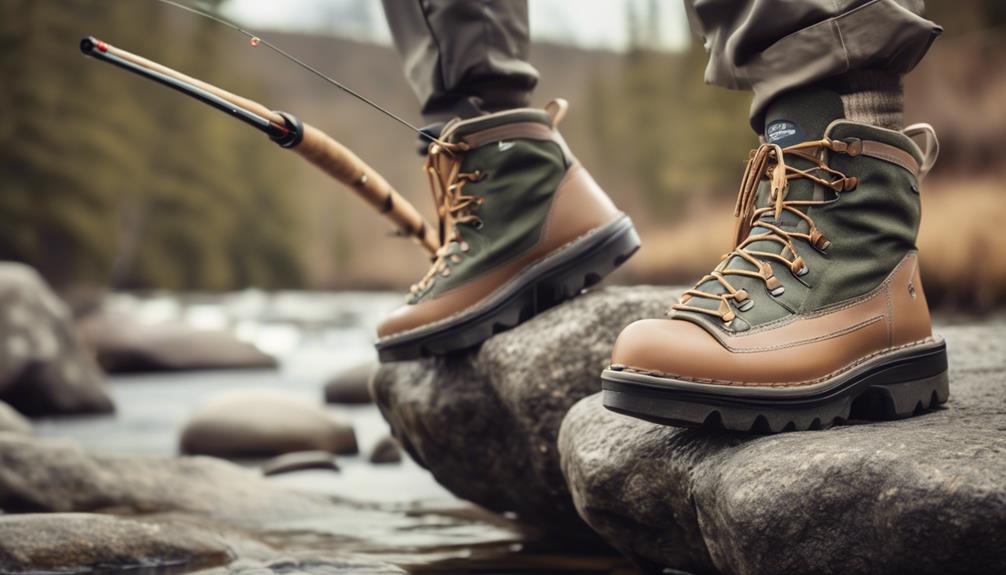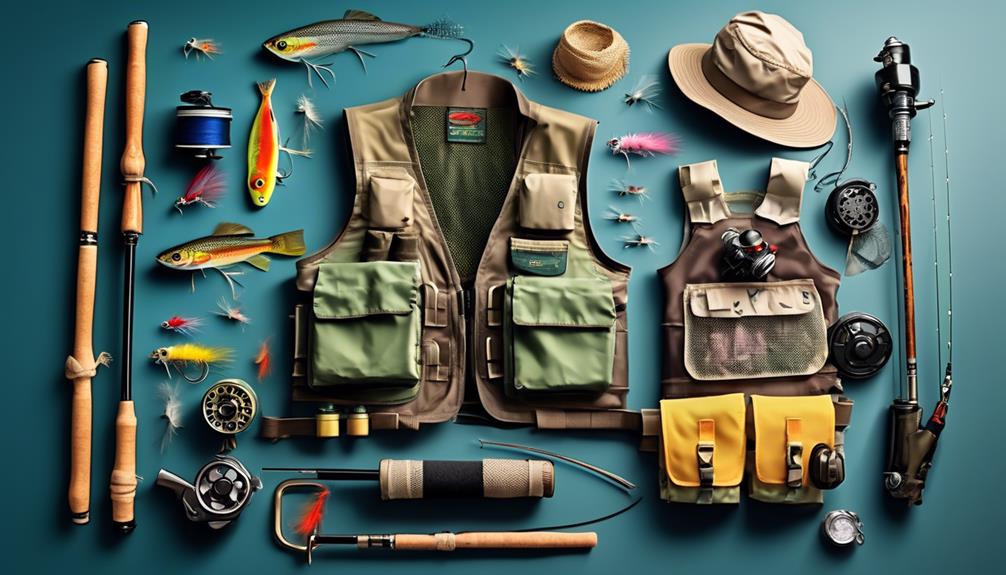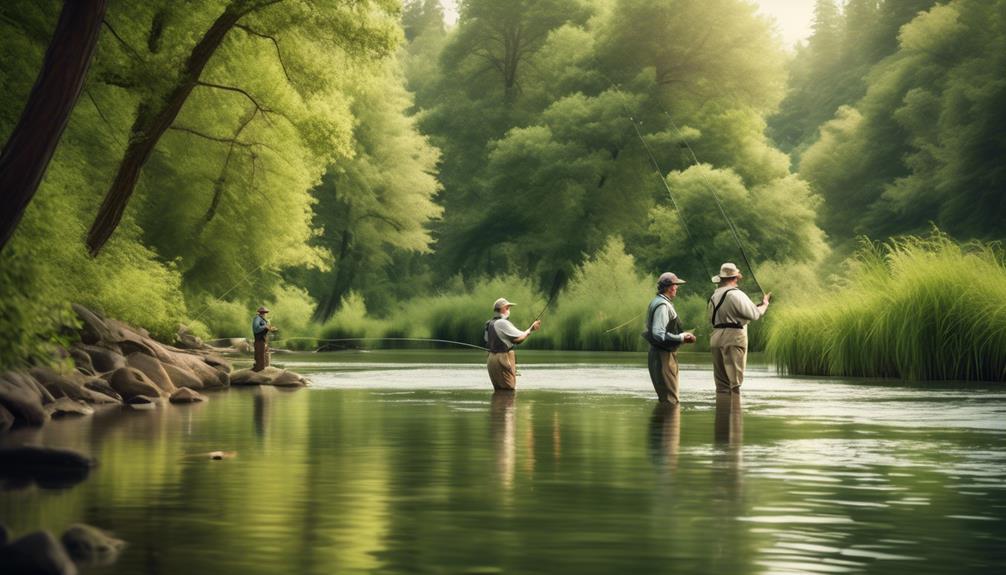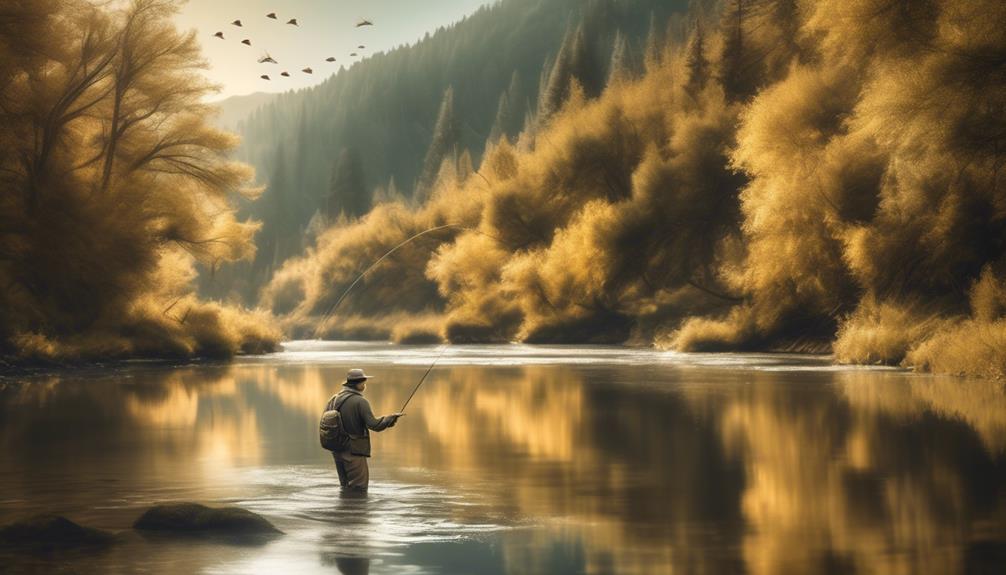So, you've decided to take the plunge into the world of fly fishing. As a beginner, it's easy to feel overwhelmed by the wide array of gear available to you. From rods to reels, lines to flies, waders to boots, the choices can be daunting.
But fear not, because with the right guidance, you can navigate through the essential gear needed to embark on your fly fishing journey. Whether you're looking to cast your line in tranquil rivers or challenging streams, having the right gear is crucial to your success.
Let's shed some light on the fundamental pieces of equipment that every novice fly angler should consider.
Fly Rods
When selecting a fly rod, consider the type of fish you'll be targeting and the size of the water you'll be fishing in. Different fish species and water sizes require different rod weights and lengths. For smaller streams and ponds, a lighter rod between 2-4 weight is suitable, while for larger rivers and bigger fish, a 5-8 weight rod is more appropriate.
Understanding the casting techniques is also crucial. For beginners, a medium action rod is a good choice as it provides more flexibility and forgives minor casting mistakes. As you become more experienced, you may opt for a fast action rod for longer casts and greater accuracy.
Rod maintenance and storage tips are vital to prolong the life of your fly rod. After each use, clean the rod with a soft cloth and mild soap to remove any dirt or grime. Inspect the rod for any signs of damage and make any necessary repairs. When storing the rod, avoid leaving it in direct sunlight or extreme temperatures as this can weaken the rod material over time. Use a protective case or sleeve to keep the rod safe from accidental damage.
Reels
Selecting the appropriate reel for your fly fishing setup is crucial for a balanced and effective angling experience. When it comes to reels, there are a few key factors to consider to ensure you make the right choice for your needs.
Here's what you need to know about reels to enhance your fly fishing experience:
- Reel Maintenance and Proper Storage
Keeping your reel clean and properly maintained not only extends its lifespan but also ensures smooth operation when you're out on the water. Proper storage, such as using a reel case or bag, protects your reel from dust, moisture, and damage, preserving its functionality for years to come.
- Different Reel Retrieval Methods
The type of fish you're targeting and the water conditions you'll encounter will determine the most suitable retrieval method. Whether it's single-action, multiplying, or automatic, each retrieval method offers a unique angling experience, adding an element of excitement and anticipation to your fishing trips.
- Drag Systems
Understanding the various drag systems, such as click-and-pawl, disc, or spring-and-pawl, is essential for controlling the resistance on your line when a fish takes the bait. The right drag system not only enhances your ability to reel in fish of different sizes but also adds a sense of control and precision to your angling pursuits.
Fly Lines
To optimize your fly fishing experience, it's essential to understand the role and significance of fly lines in your angling setup. The type of fly line you choose can greatly impact your casting ability and presentation of the fly. There are different types of fly lines designed for specific fishing conditions, so it's important to select the right one for your needs.
Weight forward (WF) floating fly lines are the most common choice for beginners. They're designed to help anglers cast with ease and accuracy, making them ideal for a wide range of fishing situations. The weight is concentrated in the front section of the line, allowing for better control and longer casts.
If you're looking to fish deeper waters, a sinking tip fly line might be the better option. The sinking tip allows your fly to reach greater depths, making it suitable for fishing in rivers and lakes where fish tend to dwell below the surface.
Another alternative is the shooting head fly line, which features a condensed, heavy front section that enables long-distance casting and is particularly useful in windy conditions.
When selecting a fly line, consider the type of water you'll be fishing in and the species you'll be targeting. Understanding the different characteristics of fly lines will help you make an informed decision and improve your overall fly fishing experience.
Leaders and Tippets
Considering the importance of fly lines in your setup, understanding the role of leaders and tippets is crucial for enhancing your fly fishing skills. Leaders and tippets are essential components of your fly fishing gear, connecting the fly line to the fly and ensuring a successful presentation. Here's what you need to know about leaders and tippets to improve your fishing experience:
- Knot Tying Techniques: Mastering knot tying techniques for connecting leaders to the fly line and tippets to the fly is crucial. The right knots ensure a secure connection, giving you the confidence to cast your line without worrying about breakage.
- Proper Use: Understanding the proper use of leaders and tippets in different fishing situations can significantly impact your success. Whether you're targeting trout in a small stream or casting for bass in a larger river, knowing how to select the appropriate leader and tippet lengths can make all the difference.
- Different Types, Material Choices: Exploring the different types of leaders and tippets, along with their material choices, allows you to tailor your setup to specific fishing conditions. From nylon to fluorocarbon materials, each type offers distinct advantages, and choosing the right one can greatly enhance your fishing performance.
Flies
When fly fishing, choosing the right flies for the target species and fishing conditions is essential for a successful outing. Fly selection is crucial, and understanding when to use nymphs versus dry flies can significantly impact your success. Nymphs are designed to imitate the immature form of aquatic insects, and they're typically fished below the surface. On the other hand, dry flies are made to resemble adult insects that land on the water's surface, making them a great choice for when fish are actively feeding on top. Understanding the behavior of the fish and the local insect hatches will help you determine which type of fly to use.
Learning to tie your own flies can be incredibly rewarding. There are various techniques for tying flies, and it's important to practice and refine your skills over time. When tying flies, the choice of materials and tools is crucial. Common materials include feathers, fur, and synthetic materials, which are used to create the body, wings, and tails of the fly. Tools such as vise, bobbin, hackle pliers, and whip finisher are essential for efficiently tying flies. Understanding the anatomy of different fly patterns and their intended use will guide you in selecting the appropriate materials and tools for each specific fly you tie.
Mastering the art of fly selection and developing the skills to tie your own flies won't only enhance your fly fishing experience but also provide a deeper connection to the sport.
Waders
Make sure your waders fit comfortably and provide adequate insulation for the water conditions you'll be fishing in. Choosing the right waders is crucial for a successful and enjoyable fly fishing experience. Here's how to find the perfect pair and care for them properly:
- Finding the right fit
- When you try on waders, pay attention to how they feel around your legs and chest. You want them to be snug without restricting your movement. A proper fit won't only enhance your comfort but also increase your maneuverability in the water, allowing you to cast and wade with ease.
- Test the waders by bending, crouching, and walking around the store. The fit should remain comfortable and flexible as you move. This will ensure that you can navigate the river or stream without feeling constricted.
- Wader materials
- Consider the materials used in the construction of the waders. Breathable materials are ideal for warmer weather, as they prevent overheating and excessive sweating. On the other hand, neoprene waders provide excellent insulation for colder conditions, keeping you warm and dry during extended periods in the water.
- Best wader care
- After each use, rinse off any dirt or debris from your waders with clean water. Hang them to dry thoroughly before storing them to prevent mildew and odors. Regularly inspect the waders for any signs of wear or damage, and make timely repairs to extend their lifespan.
Choosing the right waders and maintaining them properly will ensure that you stay comfortable and protected while enjoying your fly fishing adventures.
Boots

Ensure that your boots provide sturdy ankle support and a reliable grip for navigating slippery riverbeds and rocky terrain during your fly fishing expeditions. When choosing the right size, it's crucial to prioritize comfort and functionality. Ill-fitting boots can cause discomfort and blisters, which may hinder your fishing experience. When trying on boots, wear the same type of socks you'd wear while fly fishing to ensure the perfect fit. Remember that some boots may require going up a size to accommodate thicker socks. Additionally, consider the type of waders you'll be wearing with the boots. If you plan to wear thick, insulated waders, you may need a larger boot size to accommodate them comfortably.
Proper care is essential for maximizing the lifespan of your fly fishing boots. After each use, rinse off any dirt, mud, or debris from the boots and allow them to air dry thoroughly. Avoid storing them in hot or damp areas, as this can cause the materials to deteriorate. Regularly check the laces, soles, and seams for any signs of wear and tear, and address any issues promptly to prevent them from worsening. Applying a waterproofing treatment can help maintain the quality and performance of your boots, especially if they're made of leather.
Accessories
After ensuring your fly fishing boots are in top condition, it's time to explore the essential accessories that can enhance your fishing experience. These accessories not only add convenience and functionality but also provide protection and organization, allowing you to focus on the joy of fishing.
- Fly Boxes for Organization: Keeping your flies organized is crucial for a successful fishing trip. There's a certain satisfaction in opening a well-organized fly box, knowing you have the right fly at your fingertips. It eliminates the frustration of rummaging through a cluttered box and allows you to spend more time fishing and less time searching for the perfect fly.
- Polarized Sunglasses for Eye Protection: A good pair of polarized sunglasses not only protects your eyes from the sun's glare reflecting off the water but also enhances your ability to see beneath the surface. The moment when you spot a trout holding in the current is exhilarating, and polarized sunglasses make that moment possible by reducing the water's surface glare.
- Nippers and Retractors for Convenience: Nippers and retractors may seem like small additions, but they make a big difference in your fishing experience. It's the little things that add up to a more enjoyable trip. The satisfaction of having your nippers handy when you need to change flies or trim your line is immeasurable.
With these accessories in your arsenal, you'll be well-equipped to make the most of your fly fishing adventures.
Frequently Asked Questions
What Are the Best Types of Sunglasses for Fly Fishing?
When it comes to fly fishing, the best types of sunglasses have polarized lenses for reducing glare, UV protection, a proper fit, and a lens color that enhances visibility. Look for a durable lens material and a frame style that stays put on your face.
Are There Any Essential Accessories for Fly Fishing That Are Often Overlooked?
When fly fishing, don't overlook essential accessories like a good-quality net, line clippers, and a waterproof fly box. These must-have items can make your experience more enjoyable and successful on the water.
How Should I Properly Store My Fly Fishing Gear During the Off-Season?
When storing your fly fishing gear during the off-season, make sure to clean and dry your rod, store your reel in a protective case, maintain your fly line, and organize your fly box to keep everything in good condition.
What Are Some Common Mistakes That Beginners Make When Selecting Fly Fishing Gear?
When selecting fly fishing gear, common mistakes beginners make include not considering rod weight, using the wrong line weight, and neglecting proper gear maintenance. Remember these tips for successful gear selection and enjoyable fishing experiences.
Can You Provide Some Tips for Maintaining and Caring for Fly Fishing Gear to Ensure Its Longevity?
To keep your fly fishing gear in top shape, follow these cleaning tips and storage solutions. Regularly clean your gear with mild soap and water, and store it in a cool, dry place to prevent damage.
Conclusion
So there you have it, the essential gear for fly fishing.
With a good rod, reel, line, and a selection of flies, you'll be ready to hit the water.
Don't forget your waders and boots to stay dry and comfortable.
And of course, some leaders, tippets, and accessories will help improve your chances of a successful catch.
Now go out there and enjoy the peaceful and rewarding experience of fly fishing!



